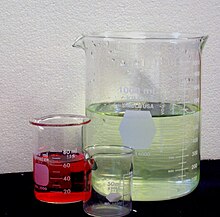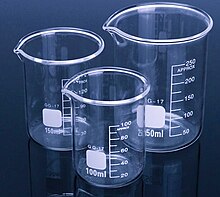What Is The Purpose Of The Piece Of Filter Paper Inside The 400 Ml Beaker?
 Beakers of several sizes | |
| Uses | Liquid volume containment and measurement |
|---|---|
| Related items | Laboratory flask |
In laboratory equipment, a beaker is more often than not a cylindrical container with a flat bottom.[1] Most also have a small spout (or "beak") to aid pouring, as shown in the film. Beakers are bachelor in a wide range of sizes, from one milliliter upward to several liters. A chalice is distinguished from a flask past having direct rather than sloping sides. The exception to this definition is a slightly conical-sided beaker chosen a Philips beaker. The beaker shape in general drinkware is similar.
Beakers are normally fabricated of drinking glass (today normally borosilicate drinking glass[ii]), but can besides be in metal (such every bit stainless steel or aluminum) or certain plastics (notably polythene, polypropylene, PTFE). A common use for polypropylene beakers is gamma spectral analysis of liquid and solid samples.

Beakers of unlike sizes
Structure and use [edit]

(A) A low-form or Griffin class beaker
(B) A tall-form or Berzelius beaker
(C) A flat beaker or crystallizer
Standard or "depression-class" (A) beakers typically have a height about 1.four times the diameter.[2] The common low course with a spout was devised by John Joseph Griffin and is therefore sometimes chosen a Griffin chalice.[three] [4] These are the most universal grapheme and are used for various purposes—from preparing solutions and decanting supernatant fluids to holding waste fluids prior to disposal to performing simple reactions. Low form beakers are likely to be used in some way when performing a chemic experiment. "Tall-form" (B) beakers have a height about twice their diameter.[2] These are sometimes called Berzelius beakers and are mostly used for titration.[4] Flat beakers (C) are often chosen "crystallizers" considering most are used to perform crystallization, but they are as well often used every bit a vessel for use in hot-bathroom heating. These beakers usually do not take a flat scale.
The presence of a spout means that the beaker cannot have a chapeau. Withal, when in use, beakers may be covered by a watch glass to prevent contamination or loss of the contents, just allowing venting via the spout. Alternatively, a beaker may be covered with another larger beaker that has been inverted, though a watch glass is preferable.
Beakers are often graduated, that is, marked on the side with lines indicating the volume independent. For instance, a 250 mL chalice might be marked with lines to signal l, 100, 150, 200, and 250 mL of volume. These marks are not intended for obtaining a precise measurement of volume (a graduated cylinder or a volumetric flask would be a more than appropriate instrument for such a job), simply rather an estimation. Most beakers are authentic to within ~10%.[5]
Standards [edit]
DIN EN ISO 3819:2015-12 defines the post-obit types and sizes:[6]
| Type | Nominal book (ml) | Outer diameter (mm) +/- five % | Overall height (mm) max. | Wall thickness (mm) min. |
|---|---|---|---|---|
| Low high beaker | 5 | 22 | 32 | 0.vii |
| 10 | 26 | 37 | 0.vii | |
| 25 | 34 | 52 | 0.vii | |
| l | 42 | 62 | 0.8 | |
| 100 | 50 | 72 | 0.9 | |
| 150 | sixty | 82 | one.0 | |
| 250 | 70 | 97 | ane.1 | |
| 400 | 80 | 113 | 1.ii | |
| 500 | 85 | 118 | ane.3 | |
| 600 | 90 | 128 | 1.3 | |
| 800 | 100 | 138 | 1.three | |
| 1000 | 105 | 148 | one.iii | |
| 2000 | 130 | 188 | 1.4 | |
| 3000 | 150 | 214 | 1.7 | |
| 5000 | 170 | 274 | 2.0 | |
| 10000 | 220 | 360 | two.0 | |
| High beaker | 50 | 38 | 72 | 0.eight |
| 100 | 48 | 82 | 0.nine | |
| 150 | 54 | 97 | i.0 | |
| 250 | lx | 123 | one.one | |
| 400 | 70 | 133 | 1.ii | |
| 500 | 79 | 140 | 1.3 | |
| 600 | eighty | 153 | 1.3 | |
| 800 | 90 | 178 | 1.3 | |
| 1000 | 95 | 183 | one.3 | |
| 2000 | 120 | 244 | i.4 | |
| 3000 | 135 | 284 | i.vii | |
| 5000 | 160 | 324 | 2.0 | |
| Thick wall type | 150 | sixty | 82 | one.xi |
| 250 | 70 | 97 | one.2 | |
| 400 | 80 | 111 | 1.iv | |
| 600 | xc | 127 | i.four | |
| k | 105 | 147 | 1.4 | |
| 2000 | 132 | 187 | i.5 | |
| 5000 | 170 | 275 | 2.5 |
Run into also [edit]
- Beaker (drinkware)
- Beaker (archaeology)
- Chalice (disambiguation)
- Volumetric flask
- Stirring rod
- Test tube
- Graduated cylinder
- Scoop
References [edit]
- ^ Oxford English Lexicon 1989 edition
- ^ a b c British Standard 6523 (1984) Drinking glass beakers for original experiments use
- ^ A. I. Vogel (1974) Practical Organic Chemistry Third edition (Longman, London) folio 46 ISBN 0-582-44245-i
- ^ a b Chemistry World August 2011 Classic kit: Griffin's Chalice
- ^ "Beakers". Retrieved October xx, 2014.
- ^ ISO 3819:2015-12
Further reading [edit]
- ASTM E960 - 93 (2008) Standard Specification for Laboratory Glass Beakers
External links [edit]
What Is The Purpose Of The Piece Of Filter Paper Inside The 400 Ml Beaker?,
Source: https://en.wikipedia.org/wiki/Beaker_%28laboratory_equipment%29
Posted by: moorekrounist.blogspot.com


0 Response to "What Is The Purpose Of The Piece Of Filter Paper Inside The 400 Ml Beaker?"
Post a Comment